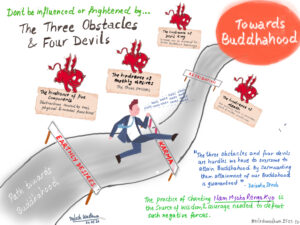Nichiren Daishonin Buddhism emphasizes the transformative power of individual faith and practice to overcome life’s challenges and obstacles. One central concept is the concept of “Three Obstacles and Four Devils,” which represents the internal and external forces that hinder practitioners from advancing on the path to enlightenment.
This teaching highlights the struggles inherent in spiritual practice and provides guidance on how to confront and overcome them.
Origins and Context
The concept of the Three Obstacles and Four Devils (also known as ‘sansho shima’ in Japanese) originates from the teachings of Shakyamuni Buddha and later elucidated in the writings of T’ien-t’ai and other Buddhist scholars. Nichiren Daishonin incorporated and expanded on this concept to address the realities faced by his followers in striving for enlightenment through the practice of chanting Nam-myoho-renge-kyo. He emphasized that encountering these obstacles is inevitable when one commits to a path of profound spiritual transformation.

The Three Obstacles
The “Three Obstacles” refer to three types of challenges that impede spiritual progress:
- Obstacles of Earthly Desires (Bonno-sho): These arise from delusions, attachments, and desires that distract practitioners from their spiritual goals. For example, greed, anger, and ignorance can lead to behaviors that cloud judgment and impede personal growth.
- Obstacles of Karma (Gosho-sho): These are the results of past actions (karma) that manifest as misfortune or adversity. For instance, illness, financial difficulties, or strained relationships may surface, challenging one’s resolve.
- Obstacles of Retribution (Ho-sho): These obstacles occur when external forces, such as societal pressures or persecution, attempt to derail spiritual practice. In Nichiren’s time, this could include criticism or hostility faced by those who practiced the Lotus Sutra.
The Four Devils
The “Four Devils” are more nuanced, representing psychological and spiritual impediments:
- Devil of the Five Components (Bonno-ma): This refers to the distractions and disturbances caused by one’s physical and mental faculties, such as the body, perception, and consciousness. These can manifest as self-doubt or complacency.
- Devil of Earthly Desires (Go-ma): This devil exploits worldly attachments to create conflict and suffering. It represents the temptation to abandon spiritual practice in pursuit of fleeting pleasures.
- Devil of Death (Shinga-ma): This is the fear of death or loss that undermines courage and determination. For instance, encountering illness or other existential threats might deter practitioners from maintaining faith.
- Devil of the Sixth Heaven (Tenji-ma): This devil represents the most insidious form of hindrance, often referred to as the “Devil King of the Sixth Heaven.” It embodies forces of arrogance, greed, and manipulation that seek to dominate and control others, steering them away from the path of enlightenment. The Devil King works by exploiting human vulnerabilities, such as ego and self-centered desires, to create division, disrupt harmony, and hinder spiritual progress. In Nichiren Daishonin’s teachings, this devil symbolizes the pervasive forces in society that promote materialism, selfish ambition, and power struggles. It manifests not only as internal tendencies but also as external pressures, such as oppressive systems or influential individuals who discourage genuine spiritual growth. Overcoming this devil requires unwavering faith, humility, and a commitment to fostering compassion and altruism through one’s practice of Nam-myoho-renge-kyo.
Overcoming Obstacles and Devils
Nichiren Daishonin taught that encountering the Three Obstacles and Four Devils is not a sign of failure but rather evidence of progress. He famously stated, “If you advance, there will be three obstacles and four devils. If you retreat, there will be no such obstacles or devils.” This means that these challenges arise precisely because the practitioner is moving closer to enlightenment.
The key to overcoming these obstacles lies in unwavering faith and persistent practice. Chanting Nam-myoho-renge-kyoserves as both a shield against negativity and a source of inner strength. By tapping into the limitless potential of the Buddha nature within, practitioners can transform even the most formidable challenges into opportunities for growth.
Relevance in Modern Life
In contemporary times, the Three Obstacles and Four Devils can be understood as the struggles faced in daily life, such as stress, self-doubt, societal expectations, and the temptation to abandon meaningful pursuits. Nichiren Buddhism teaches that these challenges are not to be feared but embraced as opportunities to deepen faith and cultivate resilience.
Through the practice of chanting and study, individuals learn to view obstacles not as insurmountable barriers but as catalysts for personal and spiritual transformation. This perspective empowers practitioners to navigate life’s difficulties with courage, wisdom, and compassion.
Conclusion
The concept of the Three Obstacles and Four Devils in Nichiren Daishonin Buddhism is a profound reminder that challenges are inherent in the journey toward enlightenment. By confronting and overcoming these obstacles through faith, practice, and study, practitioners can unlock their inner potential and lead lives of unshakable happiness. In this way, the teachings of Nichiren Daishonin offer timeless guidance for overcoming adversity and achieving lasting peace and fulfilment.
